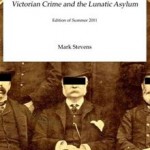 He was an artist recognized in his lifetime for uncommon talent, astonishing attention to detail, and a fascination with mythological subjects, which was aesthetically felicitous and appropriate for his Victorian upbringing.
He was an artist recognized in his lifetime for uncommon talent, astonishing attention to detail, and a fascination with mythological subjects, which was aesthetically felicitous and appropriate for his Victorian upbringing.
Richard Dadd was also tragically insane, a confessed patricide, who was destined to spend the last two-thirds of his life in asylums. His story reminds us of the madness that all too often hobbles promising artists. It also touches on the revolutionary mid-19th century developments in the treatment of mental illness, for Richard Dadd was to be committed to the care of the first generation of physicians who recognized, and attempted to treat, diseases of the mind. This was a radical departure from even a decade or so earlier, when insanity was viewed as a moral failing, and treated with the utmost level of callousness and cruelty.
touches on the revolutionary mid-19th century developments in the treatment of mental illness, for Richard Dadd was to be committed to the care of the first generation of physicians who recognized, and attempted to treat, diseases of the mind. This was a radical departure from even a decade or so earlier, when insanity was viewed as a moral failing, and treated with the utmost level of callousness and cruelty.
Dadd hailed from a well-to-do Kentish family. His talent for painting and composition was recognized from the time of his childhood, and he was accepted into the Royal Academy of Arts at an early age. His fabulous depictions of fairies and other popular supernatural motifs began receiving attention and renown, and he gained lucrative commissions for the illustration of fairy-tale books and magazines.
accepted into the Royal Academy of Arts at an early age. His fabulous depictions of fairies and other popular supernatural motifs began receiving attention and renown, and he gained lucrative commissions for the illustration of fairy-tale books and magazines.
His illness seemed to first manifest itself when he was 25. That age, and the particulars of his psychoses, suggest he suffered from schizophrenia. That diagnosis didn’t exist then, of course; indeed, he was initially thought to be afflicted with sunstroke. He was in Egypt at the time, touring with a wealthy art patron, when he became violent and delusional, asserting that he was in communication with the god Osiris.
He was sent home to recuperate, but within months of his return he attacked his father, apparently under the delusion he was a demonic imposter, and killed him. He fled to France, where he also attacked a random tourist, but was subdued and arrested. He was extradited back to England, judged criminally insane, and committed indefinitely (in the legal vernacular of the time) “until the Queen’s pleasure be known.”
He was initially committed to the notorious Bethlem Royal Hospital, from which we’ve received (thanks to etymology and lazy tongues), the context-laden word, “bedlam.” Later, he was transferred  to the newly created Broadmoor Asylum in Berkshire, where he was to spend the rest of his days.
to the newly created Broadmoor Asylum in Berkshire, where he was to spend the rest of his days.
Broadmoor was (and is) a most progressive facility for the treatment of mental illness. Its staff, in the mid-1800s, were naturally limited by contemporary understanding of brain pathology, yet they still endeavored to treat their charges with respect and compassion, to a degree unheard of at the time, and utterly rejected at places like Bedlam. He was permitted to paint, indeed encouraged to do so, and produced prolifically for more than 20 years. His case notes suggest he was a “tranquil” patient, whose delusions were nonetheless apparent during conversation, and were sadly to remain so until he died. He was for the majority of that time Broadmoor’s most famous patient (despite that facility also housing at least two attempted assassins of Queen Victoria), but by the 1880s he was mostly forgotten. He died in Broadmoor in 1886 of tuberculosis. He was 68.
One of the reasons Dadd’s story is available to us is the 2008 decision, by the Berkshire Record Office, to open the files of Broadmoor to researchers. A result of that decision is the remarkable 2011 book by  Mark Stevens, Broadmoor Revealed – Victorian Crime and the Lunatic Asylum.
Mark Stevens, Broadmoor Revealed – Victorian Crime and the Lunatic Asylum.
Stevens’s book is to be lauded for both its exhaustive scholarship and its fascinating readability. It tells the story of Victorian-era Broadmoor in a series of discrete yet contiguous stories–including a chapter on the life, death, and insanity of Richard Dadd. There is also a detailed examination of William Chester Minor, an American Civil-War surgeon who murdered a man in London in 1872. While in Broadmoor, Minor was to be a devoted, prolific, and widely celebrated contributor to the Oxford English Dictionary, then being compiled for its first edition.
Stevens also looks at some of the most popularly interesting episodes in Broadmoor’s history, such as all its escapes (there were a few escapees who were never to be heard from again). He also tracks the sometimes tragic stories of the “Broadmoor Babies”–children born at Broadmoor, usually to dangerously insane mothers. The fact that more than half of the women committed to Broadmoor were guilty of infanticide, meant that few of the babies were ever to spend time with their own families, and instead disappeared into the grim, Dickensian social welfare system of the time. It’s a sobering chapter.
There’s much such sobering tragedy in the story of Broadmoor, and of its residents, including Richard Dadd. It’s a tragedy that the promising career of Richard Dadd was interrupted by illness. But it’s a triumph, of sorts, that he was treated so well, and that he could spend his years in relative comfort and safety. And it’s a triumph, both of Broadmoor and of researchers like Mark Stevens, that we can today enjoy the work, and hear the tale, of Richard Dadd.